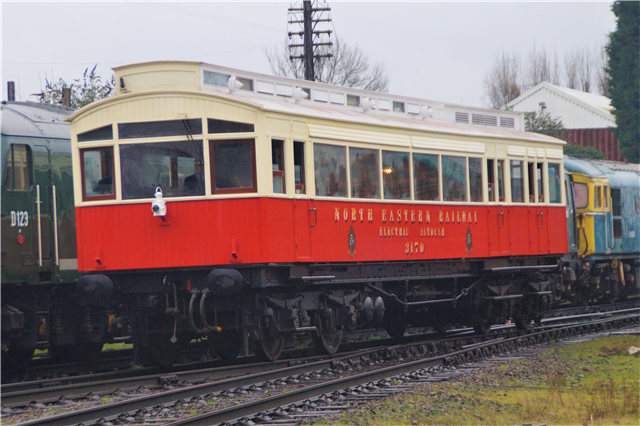The Petrol Electric Autocars were built by the North Eastern Railway in 1903 at their carriage works in York. These were powered by petrol engines which generated electricity for two traction motors which were mounted on the bogie underneath. This means of powering a railway vehicle was pioneering and would eventually be developed into the diesel-electric technology that powered and powers many locomotives worldwide. The railcars were numbered 3170 and 3171.
Various petrol engines were used, an 85 hp Napier engine was the first to be installed, but these were found to be unsatisfactory, so were replaced in 1904 by Wolseley engines. The engine had a 3-foot diameter flywheel and was coupled directly to a Westinghouse multi-polar dynamo. A small dynamo driven by belt from the flywheel provided charge for the accumulators which enabled electric starting of the engine, lighting for the carriage, and the 'exciting current' for the field coils in the main dynamo, controlled by rheostats at either end of the railcar. The engine speed could likewise be controlled via a throttle from either end of the railcar. The output from the main dynamo was sent to two electric motors, both mounted on the bogie underneath the engine room.
In 1923, No. 3170 was re-engined with a more powerful 225 hp engine, allowing it to haul an unpowered coach, an early version of the multiple units used today. Maximum speed was only 36 mph but acceleration and braking to and from this was reported to be brisk, taking around 30 seconds. In appearance, the railcars were similar to single-deck trams. The NER called them autocars, as they could be driven from either end, as with modern passenger trains. No. 3171 was withdrawn in 1930 and No. 3170 in 1931.
The body of No. 3170 was used as a holiday home near Kirbymoorside in North Yorkshire for 70 years and was bought by a railway enthusiast in 2003. A trust was formed to restore the vehicle and a trailer coach to form an Edwardian multiple unit that will be twice as old as most of the (ex-BR) DMUs on other heritage railways.
No. 3170 has now been preserved. There are several changes to the autocar, to reflect changes in railway technology and regulation. Modern regulations no longer allow the use of an old petrol engine, so a modern diesel generator has been fitted with appropriate traction motors. The power unit is based around a new diesel engine from Cummins and the chassis is a strengthened conversion of one from a GNR milk and brake van.
